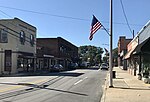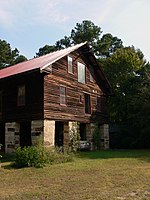Stallings-Carpenter House
Greek Revival houses in North CarolinaHouses completed in 1850Houses in Johnston County, North CarolinaHouses on the National Register of Historic Places in North CarolinaNational Register of Historic Places in Johnston County, North Carolina
The Stallings-Carpenter House, located on State Road 1713 north of Clayton, Johnston County, North Carolina, was constructed in 1845 by James and Elizabeth (Jones) Stallings in the Greek Revival style. It was added to the National Register of Historic Places on 28 Mar 1983.
Excerpt from the Wikipedia article Stallings-Carpenter House (License: CC BY-SA 3.0, Authors).Stallings-Carpenter House
Bobbit Road,
Geographical coordinates (GPS) Address Nearby Places Show on map
Geographical coordinates (GPS)
| Latitude | Longitude |
|---|---|
| N 35.691944444444 ° | E -78.458055555556 ° |
Address
Bobbit Road
Bobbit Road
27520
North Carolina, United States
Open on Google Maps






